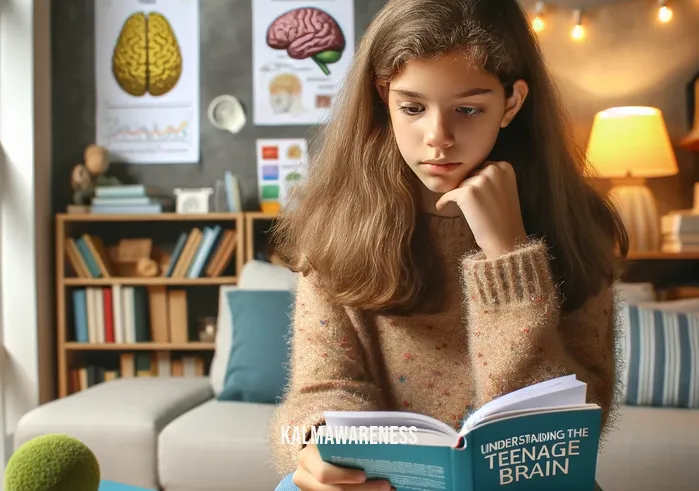Understanding the Teenage Brain: Unraveling the Mysteries of Adolescent Development
The teenage brain is a fascinating and complex subject, representing a unique stage in human development. This segment, the first of a five-part series, aims to provide a comprehensive overview of the teenage brain, setting the stage for a deeper exploration in subsequent chapters.
The Teenage Brain: A Time of Rapid Change and Development
During adolescence, the brain undergoes significant changes. These transformations are crucial for cognitive and emotional development. As explained in “The Teenage Brain”, this period is marked by both opportunities and vulnerabilities, making it a critical time for mental and emotional well-being.
Key Changes in the Teenage Brain
- Neuroplasticity: Adolescents experience heightened neuroplasticity, meaning their brains are particularly adaptable and responsive to experiences. This makes it an ideal time for learning and development.
- Emotional Development: Emotional regulation is a vital skill that evolves during adolescence. Understanding this aspect is crucial for fostering healthy mental health practices.
The Role of Mindfulness and Compassion in Teen Development
Mindfulness and compassion play pivotal roles in supporting the healthy development of the teenage brain. Integrating mindfulness practices, as discussed in “Michael Yellow Bird Mindfulness”, can significantly impact an adolescent’s ability to manage stress and emotional turmoil.
Mindfulness in Education
Implementing mindfulness practices in educational settings, such as those seen at “Warstler Elementary”, can create an environment conducive to both academic and personal growth. Educators like “Tish Jennings”, who emphasize teaching with compassion, understand the importance of nurturing the emotional well-being of students for optimal learning.
The Importance of Curiosity and Exploration
Adolescence is not just about coping with changes; it’s also a time for exploration and curiosity. Encouraging a sense of wonder, as asked in “Is Curiosity a Feeling?”, can lead to a more profound understanding of themselves and their environment.
Physical Movement and Its Impact on Adolescent Brains
Physical movement is not just beneficial for the body; it also has a significant impact on the brain. Programs that incorporate movement, like those mentioned in “Movement Books for Preschoolers”, although focused on younger children, highlight the importance of physical activity at all ages, including adolescence.
Resources for Understanding and Supporting Teenagers
There is a wealth of resources available for those interested in understanding and supporting the teenage brain. Books like “The Science of Meditation” and “Teaching with Compassion” provide valuable insights into the ways we can foster a supportive environment for teenagers.
Documentary and Academic Perspectives
For a more in-depth look, consider exploring resources like the “Documentary on Meditation” or pursuing a “Master’s Degree in Mindfulness”, which delve deeper into the science and practice of mindfulness and its impact on the developing brain.
Conclusion and Look Ahead
In this opening segment, we have briefly touched upon the complexities of the teenage brain, the significance of mindfulness and compassion, the role of curiosity and physical movement, and the resources available for further exploration. The stage is now set for a deeper dive into these topics.
In the next chapter, we will explore the emotional landscape of the teenage brain, examining how emotions are processed and regulated during these formative years. We will also look at the challenges and opportunities that this emotional development presents, both for teenagers and those who support them.
Continue reading to delve deeper into the fascinating world of the teenage brain, where we will unravel more of its mysteries and understand its profound impact on lifelong development.

Exploring the Adolescent Mind: Insights into Teenage Cognitive and Emotional Development
In this chapter, we delve deeper into the complexities of the adolescent brain, exploring its cognitive and emotional aspects. We aim to provide a richer understanding of how teenagers think, feel, and interact with their world.
The Cognitive Evolution in Teenagers
The adolescent brain undergoes significant cognitive changes, characterized by increased processing power and the development of critical thinking skills. This period is crucial for intellectual growth and the formation of personal identity.
Key Cognitive Changes:
- Enhanced Problem-Solving: The ability to tackle complex problems improves markedly during adolescence.
- Abstract Thinking Development: Teens begin to understand and conceptualize abstract ideas more effectively.
- Decision-Making Skills: The teenage brain starts to develop better decision-making processes, though this is still a work in progress.
Emotional Maturation in Adolescence
Alongside cognitive development, emotional maturation is a critical aspect of teenage years. This period involves learning to manage emotions, developing empathy, and understanding complex social dynamics.
Major Emotional Development Milestones:
- Empathy Growth: Teenagers start to exhibit a deeper understanding and empathy towards others.
- Emotional Regulation: The ability to control and express emotions in a healthy way evolves during these years.
- Social Awareness: Increased awareness of social contexts and relationships becomes evident.
The Teenage Brain and Its Social Environment
The social environment plays a pivotal role in shaping the teenage brain. Teenagers are highly influenced by their peers, family, and cultural surroundings, which impact their cognitive and emotional development.
Factors Influencing Teen Development:
- Peer Influence: Teenagers are significantly influenced by their peer groups.
- Family Dynamics: Family relationships and dynamics play a crucial role in emotional development.
- Cultural Context: The broader cultural environment impacts how teenagers view themselves and the world.
The Adolescent Brain: A Comparative Overview
| Age Range | Cognitive Abilities | Emotional Skills | Social Influences |
|---|---|---|---|
| 12-14 years | Basic abstract thinking | Developing empathy | Strong peer influence |
| 15-16 years | Enhanced problem-solving | Improved emotional regulation | Family dynamics impact |
| 17-19 years | Advanced decision-making | Mature empathy | Cultural context awareness |
| 20-21 years | Fully developed abstract thinking | Emotional maturity | Independent social identity |
| 22-24 years | Refined critical thinking | Advanced emotional intelligence | Integrated social influences |
Nurturing the Adolescent Mind
It’s essential to nurture the adolescent mind through appropriate guidance and support. Resources like “The Brain is Kind of a Big Deal” and “Wendy Hasenkamp” offer valuable insights into effectively supporting teenage cognitive and emotional development.
Mindfulness and Emotional Intelligence in Teens
Integrating mindfulness practices can greatly benefit the emotional intelligence of teenagers. As discussed in “Andrew Huberman Gratitude”, incorporating gratitude and mindfulness practices can enhance emotional well-being and resilience.
The Role of Creativity and Innovation
Encouraging creativity and innovation is crucial for the holistic development of the teenage brain. Resources like “Kindness 101 Videos” and “Simple Human Heart” provide creative approaches to nurturing the adolescent mind.
Conclusion and Look Ahead
In this chapter, we have explored the cognitive and emotional development of the adolescent brain and its interaction with the social environment. We also touched upon the importance of nurturing these aspects through mindfulness, creativity, and innovation.
In the next segment, we will delve into the challenges and triumphs of navigating the teenage years. We will explore how external factors such as technology, social media, and education impact the teenage brain and how teens can be supported through these challenges. Continue reading to gain deeper insights into these dynamic and transformative years.

Harnessing the Power of the Adolescent Mind: A Journey of Hope and Inspiration
In this chapter, we delve into the inspirational aspects of the teenage brain, exploring how this dynamic period of life is a wellspring of hope, creativity, and transformation. We aim to highlight the positive and inspiring elements of adolescent cognitive and emotional growth.
The Resilience and Potential of the Teenage Brain
Adolescence is a time of immense potential and resilience. The teenage brain, with its remarkable plasticity and adaptability, offers a unique opportunity for growth and transformation.
Inspiring Quotes on Teenage Potential:
- “The teenage years are not just about surviving, they’re about thriving. Within their minds lies the potential to change the world.” – A reflection on teenage potential.
- “In every adolescent’s brain is a spark of genius waiting to ignite.” – Celebrating the untapped potential in teenagers.
- “Adolescence is the rehearsal for a life well-lived.” – Highlighting the formative nature of the teenage years.
Real-Life Teenage Inspirations
We find countless examples of teenagers who have harnessed the power of their brains to create positive change and innovate. From young activists to inventors, the stories of these individuals are a testament to the potential of the adolescent mind.
Case Studies of Teenage Achievers:
- Young Innovators: Stories of teenagers who have invented new technologies or started social movements.
- Artistic Prodigies: Accounts of young artists who have impacted the world with their creativity.
- Athletic Phenomena: Tales of teenage athletes who have achieved remarkable feats at a young age.
The Role of Support and Guidance
The path to harnessing the potential of the teenage brain is often paved with support and guidance from mentors, educators, and parents. It’s essential to create environments that nurture and inspire teenagers.
Resources for Guidance:
- “I Grow Humans, What’s Your Superpower?” – An insightful resource for parents and educators.
- “Conscious Discipline Phrases” – A guide to fostering positive communication with teenagers.
Embracing the Challenges and Triumphs
The journey of adolescence is marked by both challenges and triumphs. Embracing these experiences as opportunities for growth is key to realizing the potential of the teenage brain.
Quotes Reflecting Resilience and Growth:
- “Each challenge a teenager faces is a stepping stone towards a future of innovation and success.”
- “In the heart of every challenge lies an opportunity for growth and learning.”
Nurturing Creativity and Curiosity in Adolescents
Fostering creativity and curiosity is crucial in unlocking the potential of the teenage brain. Encouraging teens to explore their passions and interests can lead to remarkable discoveries and innovations.
Encouraging Exploration:
- Creative Outlets: Encourage artistic expression and creative pursuits.
- Curiosity and Learning: Promote a love for learning and exploration of new ideas.
Conclusion and Look Ahead
In this chapter, we have explored the inspiring potential of the adolescent mind, highlighting the resilience, creativity, and transformative power of teenagers. We’ve seen how support and guidance can nurture this potential, leading to remarkable achievements and growth.
In the next chapter, we will delve into the practical aspects of nurturing the teenage brain. We’ll explore strategies for parents, educators, and mentors to effectively support and guide teenagers through this pivotal stage of their lives. Continue reading to discover how to effectively channel the dynamic energy of the adolescent mind towards positive and productive outcomes.
@
Navigating the Complexities of Adolescent Neurology: Insights into the Teenage Brain
In this chapter, we delve into the intricate workings of the adolescent mind, employing bullet points and lists to methodically break down the complexities of the teenage brain. Our focus is to provide a clear and thorough understanding of this crucial developmental stage.
Understanding the Teenage Brain: Key Components
The adolescent brain is not just a smaller version of an adult brain. It’s a dynamic, evolving structure with unique characteristics.
Major Areas of the Teenage Brain:
- Prefrontal Cortex: Responsible for decision-making, planning, and self-control.
- Amygdala: Plays a key role in processing emotions.
- Hippocampus: Central to memory formation and learning.
The Developmental Stages of the Teenage Brain
Adolescent brain development is a progressive journey, marked by several key stages.
Stages of Brain Development:
- Early Adolescence (12-14 years): Rapid growth in the amygdala and hippocampus.
- Mid-Adolescence (15-17 years): Significant developments in the prefrontal cortex.
- Late Adolescence (18-24 years): Refinement of neural connections and maturation of the brain.
Cognitive and Emotional Changes
Teenagers experience a wide range of cognitive and emotional changes as their brains develop.
Cognitive and Emotional Milestones:
- Improved Abstract Thinking: Enhanced ability to understand complex concepts.
- Emotional Intensity: Heightened emotional experiences due to brain development.
- Risk-Taking Behavior: Increased propensity for risk-taking, linked to brain maturation.
The Impact of External Factors
Various external factors significantly influence the development of the teenage brain.
Influential Factors:
- Social Environment: Peer pressure, family dynamics, and cultural influences.
- Lifestyle Choices: Diet, exercise, and sleep patterns.
- Technology and Media Exposure: Effects of social media and digital technology on brain development.
Strategies for Supporting Teenage Brain Development
Providing the right support and environment is crucial for healthy adolescent brain development.
Supportive Measures:
- Encouraging Healthy Habits: Promoting a balanced diet, regular exercise, and sufficient sleep.
- Fostering Positive Relationships: Building strong family bonds and positive peer interactions.
- Limiting Negative Technology Impact: Managing screen time and digital media exposure.
Resources for Further Understanding
For those seeking to deepen their understanding of the teenage brain, the following resources offer valuable insights:
- “Is IMTA Worth It?” – Discussing the value of mindfulness training.
- “Medit Scanner Training” – Exploring technological tools for brain health.
Conclusion and Preview of the Final Chapter
This chapter has provided an in-depth exploration of the teenage brain, breaking down its complexities into digestible segments. We’ve examined the developmental stages, cognitive and emotional changes, the impact of external factors, and strategies for support.
In our final chapter, we will synthesize the insights gained throughout this series, offering a comprehensive guide on how to effectively engage and support the adolescent mind. This conclusive segment will not only summarize our journey but also provide practical tips and strategies for parents, educators, and caregivers to foster a nurturing and supportive environment for teenagers. Stay tuned for this essential culmination of our exploration into the teenage brain.
@
Reflecting on the Journey: Insights and Inspirations from the World of the Teenage Brain
As we conclude our exploration of the teenage brain, we reflect on the insights and understanding we’ve gained about this dynamic and critical phase of human development. This final chapter aims to summarize our journey, offering a refreshing outlook on the world of the adolescent mind.
Summarizing the Journey
Our exploration began by understanding the basic structure and function of the teenage brain, delving into its rapid developmental changes and the role of mindfulness in shaping these formative years. We then moved to the inspirational aspects, celebrating the resilience and potential of teenagers, followed by a detailed look at the complexities and unique characteristics of the adolescent mind.
Key Takeaways:
- Dynamic Development: The teenage brain is a hub of rapid growth and transformation, marked by significant cognitive and emotional changes.
- Resilience and Potential: Adolescents possess immense potential for creativity, innovation, and resilience.
- Influencing Factors: External factors like social environment, lifestyle, and technology play a crucial role in shaping the adolescent mind.
Applying Our Knowledge
It’s not enough to simply understand the teenage brain; we must apply this knowledge in real-world scenarios. This means nurturing and supporting teenagers through their developmental journey, fostering environments that encourage growth and resilience.
Real-World Application:
- Supportive Parenting and Teaching: Utilize insights to foster positive relationships and environments for teenagers.
- Healthy Lifestyle Choices: Encourage habits that support mental and physical well-being.
- Mindful Use of Technology: Promote balanced and healthy technology use.
Resources for Continued Learning
For those eager to continue exploring the fascinating world of the teenage brain, the following resources offer further insights and guidance:
- “Teenage Wild” – A deep dive into the adventurous spirit of adolescents.
- “Is Curiosity a Feeling?” – Exploring the role of curiosity in teenage development.
Engage and Explore Further
We encourage our readers to revisit previous sections of this series for a more in-depth understanding. Each chapter offers unique insights and perspectives that collectively build a comprehensive picture of the adolescent brain.
Call to Action:
- Revisit Previous Chapters: Enhance your understanding by revisiting earlier segments of our series.
- Explore Additional Content: Discover more enlightening articles and resources in our magazine.
A Heartfelt Thank You
We extend our heartfelt thanks to our readers for joining us on this enlightening journey through the world of the teenage brain. Your engagement and curiosity have made this exploration all the more rewarding.
Looking Ahead:
- Future Editions: Stay tuned for more insightful content in our upcoming editions, where we will continue to explore fascinating topics related to health, well-being, and human development.
Conclusion
In this series, we’ve navigated the complexities, challenges, and wonders of the teenage brain. We’ve seen how this period is not just a phase to be endured but a remarkable opportunity for growth, learning, and inspiration. As we conclude, we hope that this journey has not only enriched your understanding but also empowered you to positively influence the lives of the adolescents around you. Remember, the journey of learning and discovery is ongoing, and we look forward to exploring more fascinating topics with you in the future.



